If you are a regular reader of this blog, you have seen reviews of mostly good to excellent whiskies and cognacs, along with a few other spirits. Occasionally, some were not that great. However, we have rarely reviewed really inexpensive whiskies here. So, it’s time for me to take courage and review five cheap supermarket blends, listed in alphabetical order and all without an age statement: Ballantine’s, Clan Campbell, J&B, Label 5, and William Peel. Wish me luck, and have the Gaviscon ready.
What to Expect From Supermarket Blends
Supermarket blended whiskies remain a staple in many households, offering a balance of affordability and quality. Producers typically create these whiskies from a blend of grain and malt whiskies sourced from various distilleries. They design them to deliver a consistent flavour profile, making them a reliable choice for everyday drinking.
Consumers who purchase supermarket blended whiskies generally find them ‘smooth’ and easy to drink. Blenders craft these whiskies to appeal to a wide audience, often featuring a balanced flavour profile that avoids extremes. Versatile in nature, consumers can enjoy them neat, with ice, or as a base for cocktails. While they may lack the depth or complexity of premium whiskies, they offer good value and serve as a popular choice for those seeking an affordable, enjoyable drink.
Marketing plays a crucial role in the success of supermarket blended whiskies. Brands often highlight their heritage, the quality of their ingredients, and the craftsmanship involved in blending. Creative marketing campaigns, including storytelling and branding, help these whiskies stand out on crowded supermarket shelves. By crafting a compelling narrative around their products, brands attract consumers and build loyalty, even in a competitive market.
Taxes significantly impact the final price of blended whiskies. In many regions, taxes constitute a substantial portion of the retail price. For example, in the UK, taxes on Scotch whisky can reach as high as 70%, meaning a considerable part of what consumers pay goes to the government rather than to production costs. This tax burden affects the pricing strategies of retailers and producers, often resulting in higher shelf prices for consumers. In France, for a one-litre bottle of 40% ABV whisky, customs taxes amount to about €10. On a one-litre bottle sold for €20 to the final consumer, this includes €10 of taxes on alcohol and around €3.35 of VAT. This leaves approximately €6.6 for the bottle itself, covering content, container, marketing, transport, and margins for all intermediaries from producer to supermarket. Given these factors, consumers should not expect these whiskies to match their marketing claims; they won’t be rare, old, handpicked, or the finest.
If you drink these whiskies with ice or soda, you might not notice the limited flavour. Perhaps you cannot afford more expensive whiskies, or these simply suit your taste. This scenario is common, as millions of bottles sell each year.
Regular readers of this blog likely have a strong enthusiasm for whisky, and this post may not review whiskies you currently drink or that are made for you. However, you might have enjoyed (or at least drunk) these whiskies in your younger days, probably mixed with Coke, at student parties or nightclubs. Personally, I know these whiskies do not target me as a consumer, but I thought it would be interesting to revisit them with a more experienced palate.
Ballantine’s Finest Blended Scotch Whisky (±2020s) Review
The story of Ballantine’s, now the world’s second biggest-selling scotch whisky, began in 1827 when George Ballantine opened a shop in Edinburgh, later expanding into wines and spirits. In 1865, he handed the business to his son Archibald and opened a larger shop in Glasgow, where he started blending his own whiskies. The brand gained significant interest, leading George to involve another son, George Jnr, and trade under George Ballantine & Son. In 1896, five years after George Sr.’s death, the company received a Royal Warrant from Queen Victoria.
In 1910, Ballantine’s launched its flagship blend, Ballantine’s Finest. George Jnr sold the business in 1919, and it changed hands several times, notably to Hiram Walker in 1935, who expanded its distilleries and focused on European exports. By 1986, Ballantine’s had become the largest whisky brand in Europe. In 2005, Pernod Ricard acquired the brand, integrating it into its Chivas Brothers portfolio. In 2022, 9.2 million 9 L cases (12 bottles) were sold worldwide, making Ballantine’s the solid second brand in terms of volume, far behind Johnnie Walker (22.7 million cases).
This Ballantine’s Finest Blended Scotch Whisky is a non-age statement theoretically made from about 50 single malts – mostly from Miltonduff and Glenburgie – and four grain whiskies. It is bottled at 40% ABV, with chill filtration and added caramel for the colour. About €21 a 1-litre bottle at my supermarket in France, probably around £20 in the UK.
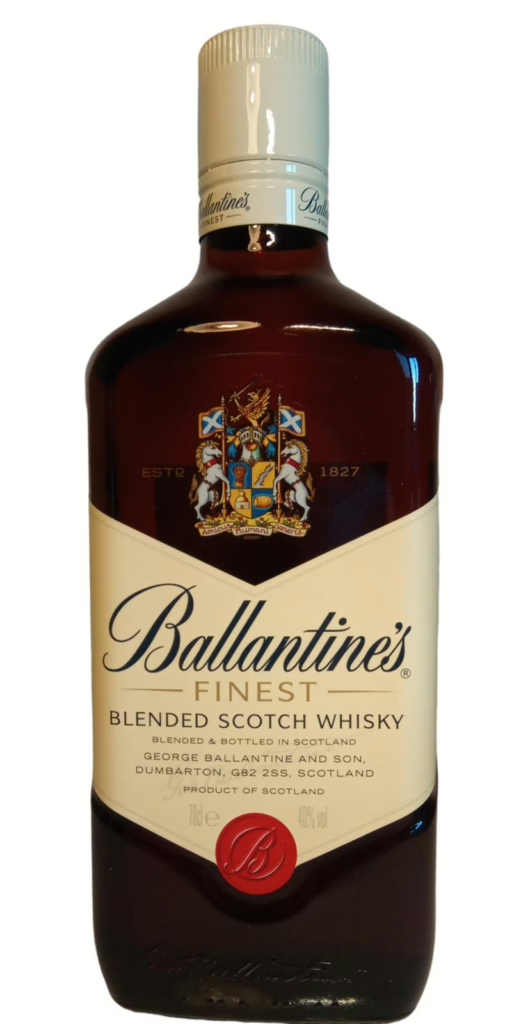
Colour:
Deep gold (fake).
Nose:
Neat: It ‘offers’ vague notes of cereals and glue, with distant smoke and orchard fruits, but lacks complexity or character.
Palate:
Neat: It arrives very lightly, with a thin mouthfeel, though not as thin as expected. Flavours of barley husk and white sugar emerge, alongside hints of concentrated caramel, apples, and pears. Pinewood planks add a touch of bitterness, accompanied by a hint of pepper.
Finish:
It delivers hints of dark chocolate, pepper, and some bitterness reminiscent of pinewood planks. The finish lingers surprisingly long.
Comments:
The entry-level Ballantine’s is not their ‘finest’ offering, but it’s not terrible either. It’s drinkable neat, although it won’t impress you enough to crave a dram at night. This Ballantine’s Finest Blended Scotch Whisky is straightforward. It would rate a 5 if the nose had more complexity, as the palate is decent, but unfortunately, it’s way too silent.
Rating: 4/10
Clan Campbell The Noble Blended Scotch Whisky (±2020s) Review
The story of Clan Campbell whisky begins with Samuel Rosenbloom, a wine merchant who transitioned into whisky under the name Forbes McGregor & Co. in Glasgow in 1933. Rosenbloom later adopted the name Ross, then Campbell, possibly inspired by his firm’s location in Campbell House. In 1934, he acquired the Glasgow blender Muir Mackenzie & Co., and around 1948, the Clan Campbell blend emerged under this name.
In 1974, S. Campbell & Son Ltd became Pernod-Ricard’s first venture into Scotch, with the Duke of Argyll, head of Clan Campbell, joining the board. Clan Campbell 5-year-old launched in France in 1978, followed by a 12-year-old in 1985, expanding into Spain, Italy, and the UK. By the late 1990s, it had surpassed a million cases in sales, becoming the world’s fastest-growing Scotch brand. By 2010, it was France’s most popular blend, with 1.7 million cases sold, though by 2022 it had reduced to 1.3 million 9 litre (12 bottles) cases. Pernod-Ricard sold the brand to Stock Spirits in 2023.
The Clan Campbell ‘The Noble’ is the only whisky left in their range, as the age statement expressions have disappeared from their range. There’s no information about the malt and grain whiskies being part of this blend. It is bottled at 40%, with chill filtration and added colouring. Less than €20 a one-litre bottle in France
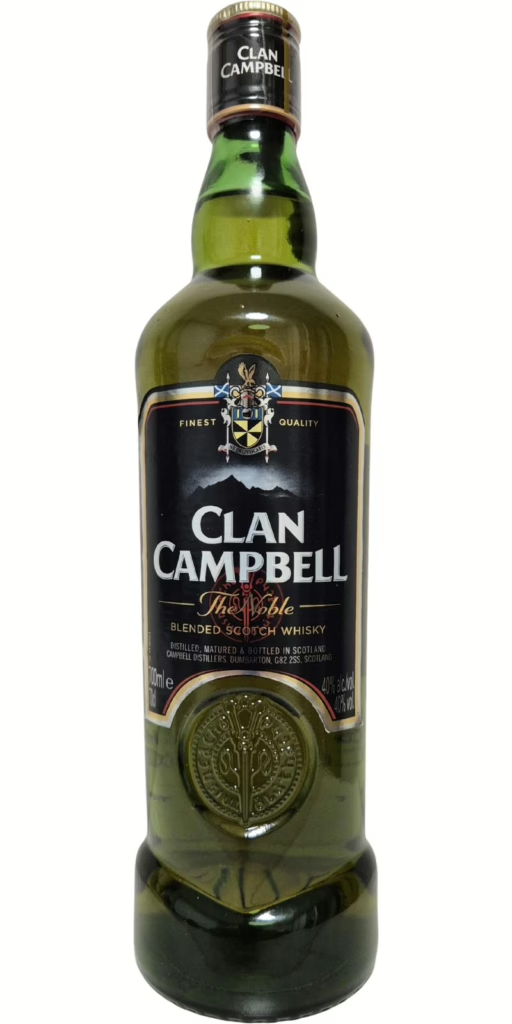
Colour:
Deep gold (probably coloured).
Nose:
Neat: Initially, there is very little aroma, even less than Ballantine’s. Upon closer inspection, there are distant hints of solvent and glue. Additionally, there may be some notes of barley sugar and wood. Furthermore, grain and digestive biscuits are detectable.
Palate:
Neat: The mouthfeel is very thin. Upon tasting, the arrival is light and sugary, with a woody undertone. However, the predominant flavours are grainy and reminiscent of wood planks. There are also notes of caramel and fructose syrup, with slight hints of apples.
Finish:
The finish is characterised by a chocolate-y and woody bitterness, accompanied by the taste of decaying apple peel. Unfortunately, the finish is too long, as it becomes overly reminiscent of wood planks.
Comments:
Here’s the rewritten version:
Last year, I tried Clan Campbell ‘The Noble’ blended Scotch whisky at a whisky show (under duress), both neat and with some ginger ale. I couldn’t finish either. I was forced to try it. Boy, it wasn’t good. For this review, a single centilitre was more than enough, and I’m glad I didn’t need more.
Rating: 3/10
J&B Rare Blended Scotch Whisky Review
Justerini & Brooks (J&B) traces its origins back to 1749 when Giacomo Justerini, an Italian immigrant, partnered with George Johnson in London to establish a wine merchant business. The company was renamed Justerini & Brooks in 1831 after Alfred Brooks acquired it. While initially focused on wine and spirits, the firm shifted towards Scotch whisky blending in the late 19th century, capitalising on the growing popularity of Scotch as an alternative to brandy. Their early blend, J&B Club, set the stage for future innovations in whisky blending.
The iconic J&B Rare blend was developed in the early 1930s by Eddie Tatham, who foresaw the potential of the American market following the repeal of Prohibition. Crafted to suit the American palate, J&B Rare combined 42 whiskies, with a core of Speyside malts like Knockando and Auchroisk. The blend quickly became a major success in the United States and later in Europe, particularly Spain, helping to establish J&B as one of the world’s most sold blended Scotch whiskies.
J&B Rare is made from more than 40 Scotch whiskies, with, as I wrote above, a core of Speyside malts like Knockando and Auchroisk. As usual, not a lot of information, but you can expect it to be chill filtered and with added colouring. Bottled at 40%, around €20 for a litre.
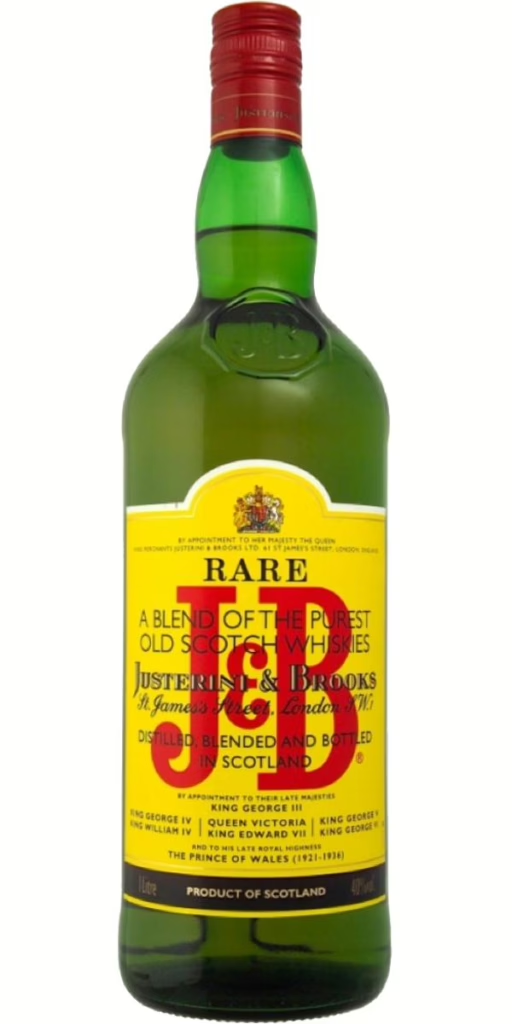
Colour:
Yellow gold (but fake).
Nose:
Neat: The nose is sharp. Initially, there are notes of grain and nail varnish remover. Additionally, there is a scent of wet straw and hints of pear and apple.
Palate:
Neat: The initial taste is of corn syrup and cardboard. There are also some notes of lemon and pepper. However, the mouthfeel is non-existent.
Finish:
The finish is quite peppery. Additionally, there are notes of cardboard and bad coffee. Unfortunately, the finish is not short enough.
Comments:
The nose is not shy compared to the previous whiskies, but this does not make it better. Intensity does not equate to quality, and the nose is sharp and rough. The palate is even less impressive. Although it lacks the sharpness of the nose, the taste is chemical and not good. This whisky is definitely not meant to be drunk neat. It might not be meant to be drunk at all. This is the first time I have given a whisky a score of 2/10 since I changed my scoring system in January 2024. It is the worst whisky I have reviewed so far. However, there are still two supermarket blends to review, so this record could be broken soon.
Rating: 2/10
Label 5 Classic Black Blended Scotch Whisky (2025) Review
Frenchman Jean Cayard founded La Martiniquaise in 1934 as a rum importer and domestic distributor. Over the decades, the company has grown into France’s second-largest spirits group and the world’s fifth-largest Scotch whisky producer. Initially focusing on Port, Cognac, and Calvados, the company ventured into Scotch whisky in 1969 with the launch of the Label 5 blend. Despite challenges in securing mature whisky stocks during a booming industry period, Label 5 steadily gained a loyal following in France before expanding its appeal globally, and now people enjoy it in over 100 countries.
In 2004, La Martiniquaise took a major step towards self-sufficiency by developing the First Blending Company in Bathgate, Edinburgh—a large maturation, blending, and bottling facility. This move was followed by the acquisition of Glen Moray distillery in 2008, a key malt component in Label 5, which coincided with a surge in sales that pushed Label 5 into the top 10 best-selling Scotch whiskies worldwide. Furthering its growth and innovation, La Martiniquaise opened Starlaw distillery in 2010, Scotland’s first new greenfield grain distillery in 40 years, supplying whisky for Label 5 and other blends like Sir Edward’s and Glen Turner. By 2022, Label 5 ranked 11th globally in blended Scotch whisky sales, with 2.5 million 9-litre cases sold, cementing La Martiniquaise’s status as a major player in the Scotch whisky industry.
Like the other blends, we just know it’s a mix of malt and grain whiskies, aged in oak casks (or it wouldn’t be Scotch) for a minimum of 3 years. It’s bottled at the usual 40% ABV, with chill filtration and added colour. My supermarket sells a 1 L bottle for less than €18.
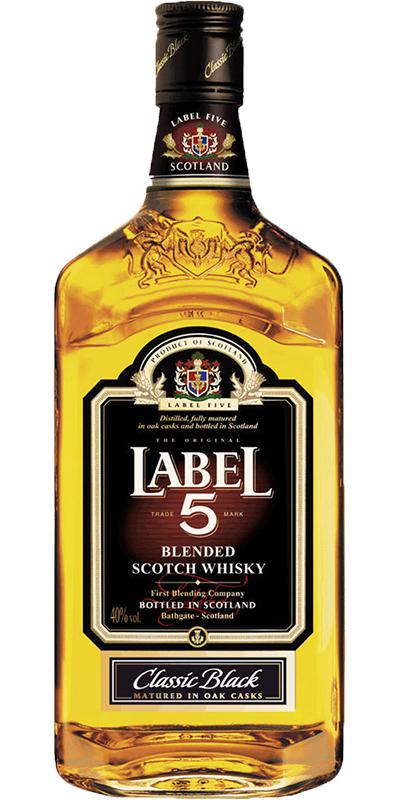
Colour:
Chestnut (fake, obviously).
Nose:
Neat: Initially, the nose is foul. There are notes of rotten fruits, compost, and grainy sharp solvent. I decided to let it breathe, hoping it would not permeate and ruin the Glencairn glass. Fortunately, I am using an unmarked one, so there is no sentimental value attached. After some time, the nose remains horrendous.
Palate:
Neat: The palate is weak and sugary, reminiscent of fructose syrup. There are also notes of fake caramel, harsh pine wood planks, and pepper heat. Let’s not mention the very thin mouthfeel. Oops, I just did. Anyway.
Finish:
The finish is cardboard-like but fortunately short.
Comments:
I find nothing to save here. The nose offers little, the palate offers little, and the finish offers little. Everything this whisky has, it manages to fail. I’m not even sure I want to keep the remaining 19 cls from my 20 cl bottle to use as a cleaning product. I will pour the rest of the content of my glass down the sink. The J&B previously broke the record for the worst rating on More Drams Less Drama, but it did not hold that title for long. This Label 5 is an even worse whisky, being the first to unlock the 1/10 rating. Because I did not include a 0/10 rating on the scoring band.
Rating: 1/10
William Peel Blended Scotch Whisky (2025) Review
Entrepreneur Bernard Magrez created the William Peel brand in 1964, initially importing various single malts under the William Peel name before establishing it as a blended whisky. Despite its relative obscurity in the UK, William Peel has become a leading blended Scotch whisky brand in France, the world’s largest export market for Scotch by volume. Its sister brand, The Glen Peel, bottled single malts until 2005, when Marie Brizard et Roger acquired most of William Pitters International’s spirits interests, shifting the focus towards William Peel blended Scotch.
In 2006, the Belvédère Group acquired Marie Brizard et Roger and renamed it Marie Brizard Wine & Spirits (MBWS). MBWS is one of the few companies approved by HMRC for Geographic Indicator (GI) status, allowing it to bottle Scotch whisky in France from bulk supply sourced in Scotland. This facilitates large-scale distribution to continental supermarkets. By 2014, William Peel was selling three million cases annually, and by 2022, it ranked ninth globally in volume, with 2.7 million cases sold, underscoring its strong presence in the European whisky market.
William Peel consists of 18 Highland and Speyside malts alongside Lowland grain whisky. It’s bottled at 40% with chill filtration and added colouring. Around €16–17 at my supermarket for a 1 L bottle.
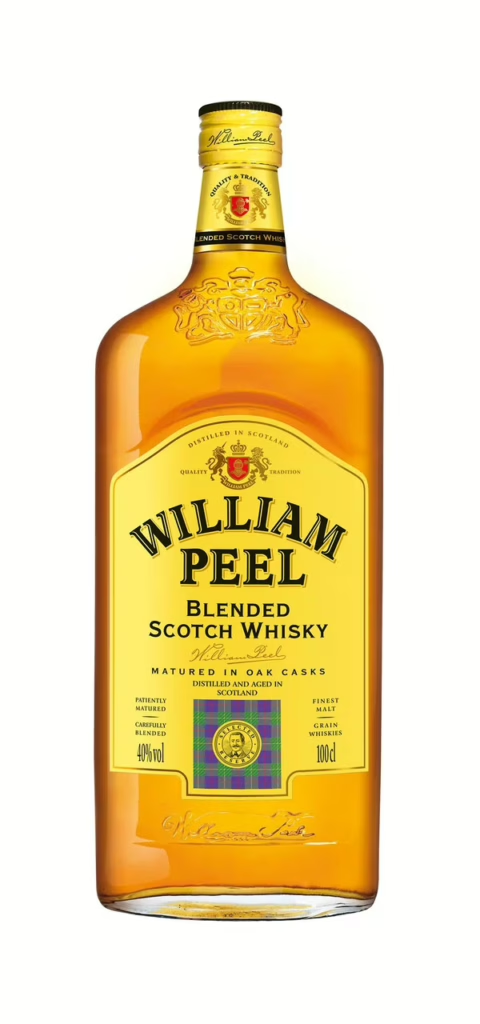
Colour:
Chestnut, and you guessed it, fake.
Nose:
Neat: The nose is similar to Label 5, with rotten fruit compost, but it is less intense. This is almost a blessing. Additionally, there are notes of corn flakes.
Palate:
Neat: The palate is close to Label 5, but it is slightly more peppery. Despite this, the taste is even weaker. I suppose it is just 99% 3-year-old grain whisky. Furthermore, there is a feeling of licking a pine wood plank with splinters.
Finish:
The finish has notes of artificial caramel and fructose syrup. Fortunately, the finish is short.
Comments:
I find nothing to save here either. I wouldn’t dare use this to disinfect a wound for fear it would make my blood rot. It is as horrendous as Label 5, which is not something to celebrate. I really hesitated to create a 0/10 rating for this William Peel, but I also considered it for Label 5.
Rating: 1/10
Final Comments
I am aware that this review might seem pointless, as regular readers of this blog are unlikely to be the target consumers for these whiskies. However, I took on the challenge of reviewing them for the sake of reference, science, and a bit of ‘fun’. I knew there was a good chance I would explore the lower ranks of the scoring scale. This post won’t impact the big brands reviewed here, nor the other major players, but that’s not the goal. To each their own. However, for those who might care, if you ever had any lingering doubts, I hope I have resolved them!
Thanks Mathieu and Davy for the ‘help’ procuring some of these whiskies. And the holes in my stomach. Pictures courtesy of Whiskybase and I don’t remember which supermarket website for the William Peel bottle.
But Don’t Trust Our Word For It…
Want another opinion and see if I was too harsh? I sent samples of those five blends to a friend who writes at the excellent website Dramface, so you can read his opinion on these blends over there!